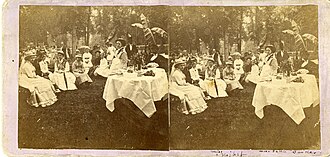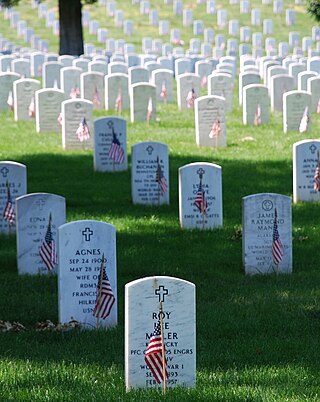
Memorial Day is one of the federal holidays in the United States for honoring and mourning the U.S. military personnel who died while serving in the United States Armed Forces. It is observed on the last Monday of May. Memorial Day is also considered the unofficial beginning of summer in the United States.

The United Daughters of the Confederacy (UDC) is an American neo-Confederate hereditary association for female descendants of Confederate Civil War soldiers engaging in the commemoration of these ancestors, the funding of monuments to them, and the promotion of the pseudohistorical Lost Cause ideology and corresponding white supremacy.

Confederate Memorial Day is a holiday observed in several Southern U.S. states on various dates since the end of the American Civil War. The holiday was originally publicly presented as a day to remember the estimated 258,000 Confederate soldiers who died during the American Civil War.

Hollywood Cemetery is a historic rural cemetery located at 412 South Cherry Street in the Oregon Hill neighborhood of Richmond, Virginia. It was established in 1847 and designed by the landscape architect John Notman. It is 135-acres in size and overlooks the James River. It is one of three places in the United States that contains the burials of two U.S. Presidents, the others being Arlington National Cemetery and United First Parish Church.

The Lost Cause of the Confederacy is an American pseudohistorical and historical negationist myth that claims the cause of the Confederate States during the American Civil War was just, heroic, and not centered on slavery. First enunciated in 1866, it has continued to influence racism, gender roles, and religious attitudes in the Southern United States into the 21st century. Historians have dismantled many parts of the Lost Cause mythos.
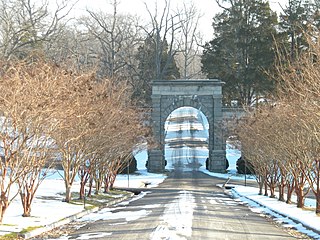
Blandford Cemetery is a historic cemetery located in Petersburg, Virginia. Although in recent years it has attained some notoriety for its large collection of more than 30,000 Confederate graves, it contains remains of people of all classes and races as well as veterans of every American war. It holds the largest mass grave of 30,000 Confederates killed in the Siege of Petersburg (1864–65) and other battles during the American Civil War. Although only 3,700 names of the interred are known, it was listed on the National Register of Historic Places in 1992, in part through the efforts of Charlotte Irving, first president of the Historic Blandford Cemetery Foundation. In addition to this cemetery's historic African American section discussed below, it is located adjacent to the People's Memorial Cemetery, a historic African-American cemetery, and small cemeteries containing additional dead from the lengthy Siege of Petersburg and Battle of the Crater in 1864.
Nora Fontaine Maury Davidson was an American schoolteacher in Petersburg, Virginia. She is credited for holding the first Memorial Day ceremony in Petersburg, and as the inspiration for the United States' Memorial Day.

The Confederate Memorial at Indian Mound Cemetery in Romney, West Virginia, commemorates residents of Hampshire County who died during the American Civil War while fighting for the Confederate States of America. It was sponsored by the Confederate Memorial Association, which formally dedicated the monument on September 26, 1867. The town of Romney has claimed that this is the first memorial structure erected to memorialize the Confederate dead in the United States and that the town performed the nation's first public decoration of Confederate graves on June 1, 1866.
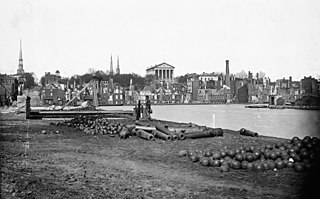
Richmond, Virginia, served as the capital of the Confederate States of America during the American Civil War from May 8, 1861, before that date the capital had been Montgomery, Alabama. Besides its political status, it was a vital source of weapons and supplies for the war effort, as well as the terminus of five railroads, and as such would have been defended by the Confederate States Army at all costs.
Confederate monuments and memorials in the United States include public displays and symbols of the Confederate States of America (CSA), Confederate leaders, or Confederate soldiers of the American Civil War. Many monuments and memorials have been or will be removed under great controversy. Part of the commemoration of the American Civil War, these symbols include monuments and statues, flags, holidays and other observances, and the names of schools, roads, parks, bridges, buildings, counties, cities, lakes, dams, military bases, and other public structures. In a December 2018 special report, Smithsonian Magazine stated, "over the past ten years, taxpayers have directed at least $40 million to Confederate monuments—statues, homes, parks, museums, libraries, and cemeteries—and to Confederate heritage organizations."

The Blandford Church is the oldest building in Petersburg, Virginia whose history is well documented. It is at the highest point in the city, atop Well's Hill. It is today (2019) part of a memorial to Southern soldiers who died during the Civil War. It is adjacent to Blandford Cemetery, one of the oldest, largest and historically significant cemeteries in Virginia. The Blandford Cemetery did not exist until after the church building had been abandoned, in the early 1800s, and the land purchased by the city to use as a cemetery.

The Confederate Memorial was a memorial in Arlington National Cemetery in Arlington County, Virginia, in the United States, that commemorated members of the armed forces of the Confederate States of America who died during the American Civil War. Authorized in March 1906, former Confederate soldier and sculptor Moses Jacob Ezekiel was commissioned by the United Daughters of the Confederacy in November 1910 to design the memorial. It was unveiled by President Woodrow Wilson on June 4, 1914, the 106th anniversary of the birth of Jefferson Davis, the President of the Confederate States of America.

Old Live Oak Cemetery is a historic cemetery in Selma, Alabama founded in 1829 and expanded in 1877. The newer portion is sometimes called New Live Oak Cemetery and the cemetery is collectively known as Live Oak Cemetery. It contains burials of Confederate States of America leaders, as well Benjamin Sterling Turner, a formerly enslaved African-American who served as U.S. Representative for Alabama during the Reconstruction era. The cemetery is at 110 Dallas Avenue approximately 0.7 miles (1.1 km) west of downtown Selma.

Mary Ann Williams was an American woman who was the first proponent for Memorial Day, an annual holiday to decorate soldiers’ graves.

Elizabeth Rutherford (1833-1873) was an American woman who is associated with the founding of Confederate Memorial Day, which itself is the forerunner of Memorial Day an annual holiday to decorate soldiers’ graves.
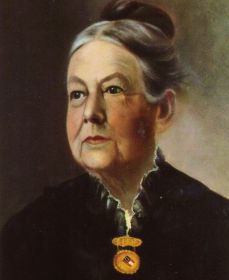
Eliza Hall "Hallie" Nutt Parsley was an American civic leader and educator. She worked as a school teacher after the American Civil War and established her own school for children in Wilmington, North Carolina, in 1894, four years before the Wilmington massacre. A war widow, she was active in glorifying the Confederacy through her role as a member of the Ladies' Memorial Association, raising money to build Confederate monuments in North Carolina. Parsley became a prominent figure within the United Daughters of the Confederacy, establishing the Cape Fear Chapter in 1894 and the North Carolina Division in 1897. She served as president of the North Carolina Division of the United Daughters of the Confederacy for two years, travelling across North Carolina to recruit new members and promote the pseudohistorical narrative of the Lost Cause of the Confederacy. Under her leadership, in 1898, the Cape Fear chapter established the Cape Fear Museum of History and Science.

Confederated Southern Memorial Association was a Neo-Confederates women's organization of unified memorial associations of the Southern United States. It was composed of 70 women's memorial associations, which had formed between 1861 and 1900. The CSMA was established at Louisville, Kentucky, on May 30, 1900. At that meeting, the women stated that they were unwilling to lose their identity as memorial associations, or to merge themselves into the United Daughters of the Confederacy. Instead, by this union of all Memorial Associations, it was believed that the women of the South would perpetuate more certainly the purposes for which each association had been individually laboring, and would more firmly cement the ties which already existed between them. An increase in membership and more intelligent knowledge of the history of the Confederate Cause would also be the natural result of annual meetings.



